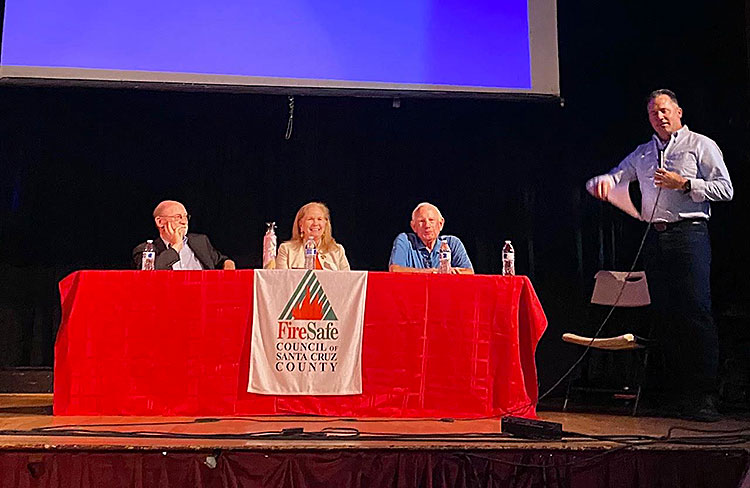By Adam Hensleigh & Michael Horn
The inaugural Wildfire Resilience Summit on June 6 was hosted by the FireSafe Council of Santa Cruz County in downtown Santa Cruz.
Residents got a comprehensive look at a roadmap to resiliency. The theme was “Break the Fire Triangle.”
Nine speakers gave talks about resilience topics. The Summit also included developing FireTech, and government panels.
 Holt Hanley, a meteorologist from KSBW, emceed the event. In between speakers, Holt shared anecdotes from field research projects during his master’s program at San Jose State University’s Fire Weather Research Laboratory.
Holt Hanley, a meteorologist from KSBW, emceed the event. In between speakers, Holt shared anecdotes from field research projects during his master’s program at San Jose State University’s Fire Weather Research Laboratory.
The FireSafe Council of Santa Cruz County Firewise Coordinator Lynn Sestak gave her “Why Go Firewise” presentation. Lynn illustrated the ease and pathways to becoming a Firewise-certified community. The continually growing program is also a way to convince insurance companies that your community is being proactive and might even get you a discount on the skyrocketing rates.
Santa Cruz County has the seventh most Firewise recognized communities nationwide at 60. Santa Cruz County also ranks fifth in the state for Firewise-recognized communities.
Laura Terrazas from the Santa Cruz County Office of Education discussed their Wildland Firefighting program. The Wildland Fire Academy is a new career technical education offering in 2024. This program really lowers entry barriers and allows affordable opportunities for many young people to begin careers as wildland firefighters.
Matt Abernathy from the Resource Conversation District discussed defensible space. He offered a different perspective, with humans as ecosystem engineers. Matt also shared landscape-scale management projects, from shaded fuel breaks to burn prep.
David Reid and Clare Peabody from the county Office of Response, Recovery & Resilience discussed what the OR3 does. Clare promoted the 2020 Recover CA Owner Occupied Mitigation program for individuals who meet income guidelines. Clare also discussed the importance of signing up for CruzAware and knowing your Community Zonehaven evacuation zone.
Cal Fire’s Soquel Demonstration Forest Manager Angela Bernheisel shared what they are doing regarding fire prevention for communities around the demonstration forest. Angela also highlighted a 175-acre sustainable timber harvest plan scheduled for completion this fall. Other projects in the State Forest included 84 acres of pile burning that was completed earlier this year.
Tim Hyland from State Parks talked about their Wildfire and Forest Resilience Program and the use of fire as a management tool for a positive recovery of the sand hills of Henry Cowell Redwoods State Park. He also outlined fire and fuel projects ranging from 50 acres in Ano Nuevo to 1,500 acres in Nisene Marks.
Similarly, Ed Fulton from the Bureau of Land Management discussed their interagency fuels project. The fuels reduction project stretches from Bonny Doon down to Davenport. Collectively, these projects are building on natural buffers to limit and reduce the spread of fast-moving wildfires.
Madronus CEO Ivan O’Neill gave a presentation on the Wildfire Prepared Homes program. Madronus is a Bay Area company that assesses a home’s vulnerability and advises homeowners on insurance companies’ expectations. O’Neill illustrated his points with science and statistics on home ignitions.
This a point that Phil Dundas, owner of The Landscape Company, affirmed, stating that firescaping was the best way to love — and not fear — your landscaping.
Pulling back the curtain of nondisclosure agreeements and secrecy, Jake Harris from DBL Partners moderated a panel that featured fireline augmenting robots, remotely operated water-dropping helicopters, and AI tools for evaluating fire risk.
The Summit concluded with a government panel moderated by local Fire Ecologist Michael Horn. The panel included State Sen. John Laird, Assembly member Gail Pellerin, and Supervisor Bruce McPherson. Covering wildfire legislation and other ways the government is helping were the main focus, but Horn pushed them on real actionable items. Laird and Pellerin brought data to the conversation about the efforts to restore insurance coverage for the thousands who have been dropped.
The FSCSCC provided attendees with a full afternoon of inspiration and hope from learning from their own community members who are actively working to make things safer.
The FireSafe Council plans to make this an annual event to help add to the existing wildfire resilience work within Santa Cruz County. The success of wildfire resilience is dependent on scale and capacity, and this event connects people and information to build that resilience to wildfires.
TOP PHOTO: Adam Hensleigh of Mount Hermon, who chairs the local FireSafe Council, introduces Sen. John Laird, Assembly member Gail Pellerin and County Supervisor Bruce McPherson.



